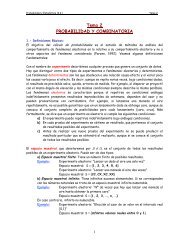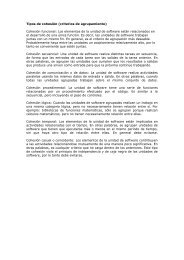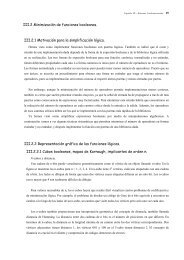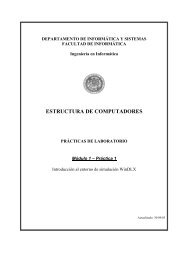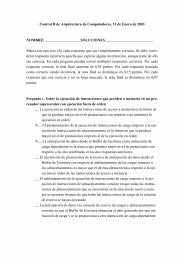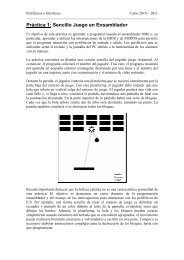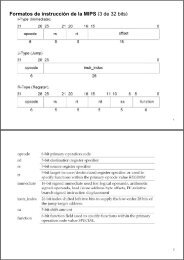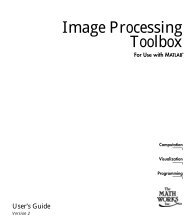2.6 Formato de instrucciones.pdf
2.6 Formato de instrucciones.pdf
2.6 Formato de instrucciones.pdf
Create successful ePaper yourself
Turn your PDF publications into a flip-book with our unique Google optimized e-Paper software.
2.5. <strong>Formato</strong> <strong>de</strong> las <strong>instrucciones</strong><br />
Representación binaria <strong>de</strong> las <strong>instrucciones</strong> en el computador.<br />
La secuencia <strong>de</strong> bits se divi<strong>de</strong> en campos que especifican la operación<br />
y los operandos.<br />
Representación sencilla:<br />
Representación más compleja:<br />
1<br />
Tamaño <strong>de</strong> las <strong>instrucciones</strong>: aspecto básico <strong>de</strong>l diseño <strong>de</strong>l formato.<br />
Compromiso entre:<br />
- Repertorio <strong>de</strong> <strong>instrucciones</strong> potente (más operaciones, más<br />
operandos, más modos <strong>de</strong> direccionamiento y mayor rango <strong>de</strong><br />
direcciones (más registros)): más bits para codificar.<br />
- Programas cortos: <strong>instrucciones</strong> cortas y <strong>de</strong> longitud fija.<br />
- Sencillez <strong>de</strong>l hardware <strong>de</strong> captación y <strong>de</strong>codificación <strong>de</strong> las<br />
<strong>instrucciones</strong>: tamaño <strong>de</strong> las <strong>instrucciones</strong> fijo e igual al tamaño <strong>de</strong> la<br />
palabra <strong>de</strong> la máquina.<br />
Los direccionamientos implícito e indirecto, permiten acortar el tamaño<br />
<strong>de</strong> la instrucción.<br />
2
Codificación <strong>de</strong> los modos <strong>de</strong> direccionamiento<br />
Según el número <strong>de</strong> modos <strong>de</strong> direccionamiento que tenga una<br />
arquitectura:<br />
3<br />
Características <strong>de</strong> los formatos <strong>de</strong> instrucción que <strong>de</strong>ben tener las<br />
arquitecturas:<br />
- Cada computador tiene unos pocos formatos: cada instrucción se<br />
ajusta a uno <strong>de</strong> ellos. Cuantos menos más sencilla la unidad <strong>de</strong><br />
control.<br />
- Son sistemáticos: campos <strong>de</strong>l mismo tipo tienen la misma longitud y<br />
ocupan el mismo sitio <strong>de</strong>ntro <strong>de</strong> la instrucción (código <strong>de</strong> operación<br />
el primero). Simplifica la <strong>de</strong>codificación <strong>de</strong> la instrucción.<br />
4
Ejemplos <strong>de</strong> formatos <strong>de</strong> <strong>instrucciones</strong><br />
IBM 360<br />
16 registros <strong>de</strong> tipo general: 0 – 15<br />
Palabra <strong>de</strong> 32 bits<br />
Modos <strong>de</strong> direccionamiento <strong>de</strong>l computador:<br />
- inmediato (8 bits)<br />
- registro: Ri (4 bits)<br />
- almacenamiento (base + <strong>de</strong>splazamiento): Bi (registro base), Di<br />
(<strong>de</strong>splazamiento <strong>de</strong> 12 bits)<br />
- in<strong>de</strong>xado: Xi (registro índice), Bi (registro base), Di (<strong>de</strong>splazamiento)<br />
Tiene 5 formatos <strong>de</strong> instrucción, según los modos <strong>de</strong> direccionamiento.<br />
2 o 3 operandos explícitos, cada uno mediante un modo <strong>de</strong><br />
direccionamiento <strong>de</strong>terminado.<br />
5<br />
6
Veamos ejemplos <strong>de</strong> <strong>instrucciones</strong> (RR, RS y SI) <strong>de</strong>l IBM 360:<br />
Especificación <strong>de</strong> las <strong>instrucciones</strong>:<br />
Descripción Código Código <strong>Formato</strong> Especificación <strong>de</strong><br />
mnemónico operación instrucc. los operandos<br />
Suma ADR 2A RR R1, R2<br />
normalizada<br />
larga<br />
Salta si BXH 86 RS R1, R3, D2(B2)<br />
índice alto<br />
Movimiento<br />
inmediato<br />
MVI 92 SI D1(B1), inmediato<br />
ADR 3, 4<br />
equivale a 0x2A34<br />
BXH 5, 8, X’6B8’(7) equivale a 0x865876B8<br />
MVI X’A49’(6), X’3F’ equivale a 0x923F6A49<br />
7<br />
El VAX<br />
<strong>Formato</strong> <strong>de</strong> instrucción muy flexible: código <strong>de</strong> operación <strong>de</strong> 8 bits,<br />
seguido <strong>de</strong> un máximo <strong>de</strong> cinco especificadores <strong>de</strong> operando:<br />
8
Cada especificador <strong>de</strong> operando se compone <strong>de</strong> dos o tres partes:<br />
1. Código <strong>de</strong>l modo <strong>de</strong> direccionamiento (4 bits):<br />
- 5: registro<br />
- 0xC: base + <strong>de</strong>splazamiento (<strong>de</strong> 16 bits)<br />
- 0xA: base + <strong>de</strong>splazamiento (<strong>de</strong> 8 bits)<br />
- Para especificar un operando inmediato los 2 bits más significativos<br />
son 00 y los 6 bits restantes (2 + 4 <strong>de</strong>l campo registro) se utilizan<br />
para codificar el valor <strong>de</strong>l operando.<br />
2. Especificación <strong>de</strong> registro (4 bits).<br />
3. Especifica opcionalmente un <strong>de</strong>splazamiento en el<br />
direccionamiento base + <strong>de</strong>splazamiento (8, 16 ó 32 bits).<br />
Veamos algunos ejemplos <strong>de</strong> <strong>instrucciones</strong> <strong>de</strong>l VAX:<br />
9<br />
10
Ejemplos:<br />
Dar la instrucción máquina equivalente a:<br />
CLRL R13<br />
MOVW 362(R3), 67(R12)<br />
ADDL3 #58, R1, 55(R11)<br />
equivale a 0xD45D<br />
equivale a 0xB0C36A01AC43<br />
equivale a 0xC13A51AC37<br />
11<br />
<strong>Formato</strong>s <strong>de</strong> instrucción <strong>de</strong> la MIPS (3 <strong>de</strong> 32 bits)<br />
12
13<br />
1. Tipo R (Registro)<br />
- opco<strong>de</strong>: código <strong>de</strong> operación primario, cuyo valor es cero.<br />
- rs: especificador <strong>de</strong> registro fuente.<br />
- rt: especificador <strong>de</strong> registro objetivo (fuente/<strong>de</strong>stino).<br />
- rd: especificador <strong>de</strong> registro <strong>de</strong>stino.<br />
- sa: cantidad <strong>de</strong> <strong>de</strong>splazamiento.<br />
- function: campo función, especifica la operación.<br />
Utilizado para <strong>instrucciones</strong> aritméticas y lógicas:<br />
14
(1.1) Tres operandos en registros<br />
ADD rd, rs, rt<br />
(rd ← rs + rt)<br />
SUB rd, rs, rt<br />
(rd ← rs - rt)<br />
15<br />
Ejemplos<br />
Modo <strong>de</strong> direccionamiento registro:<br />
16
(1.2) Dos operandos en registros<br />
SLL rd, rt, sa<br />
(rd ← rt
2. Tipo I (Inmediato)<br />
- opco<strong>de</strong>: especifica la operación.<br />
Para <strong>instrucciones</strong>:<br />
(2.1) <strong>de</strong> transferencia <strong>de</strong> datos (carga/almacenamiento):<br />
- rs: registro base.<br />
- rt: registro fuente/<strong>de</strong>stino.<br />
- offset: <strong>de</strong>splazamiento.<br />
(2.2) <strong>de</strong> salto condicional:<br />
- rs y rt: para establecer la condición.<br />
- offset: <strong>de</strong>splazamiento.<br />
(2.3) <strong>instrucciones</strong> con operandos inmediatos:<br />
- rs: operando fuente.<br />
- rt: operando <strong>de</strong>stino.<br />
- offset (inmediate): operando fuente.<br />
19<br />
(2.1) Instrucciones <strong>de</strong> carga/almacenamiento<br />
LW rt, offset(base)<br />
(rt ← memory[base+offset])<br />
SW rt, offset(base)<br />
(memory[base+offset] ← rt)<br />
20
Ejemplos<br />
21<br />
Existen <strong>instrucciones</strong> distintas para los diferentes tamaños <strong>de</strong> dato<br />
(i) Load Byte<br />
(ii) Load Half Word<br />
(iii) Load Word<br />
En todos los casos, el direccionamiento para el segundo operando es<br />
base (registro rt) + <strong>de</strong>splazamiento (offset)<br />
22
(2.2) Instrucciones <strong>de</strong> salto condicional (bifurcación)<br />
BEQ rs, rt, offset<br />
(if (rs = rt) then branch)<br />
Operación: tgt_offset ← sign_extend(offset || 0 2 )<br />
condition ← (GPR[rs] = GPR[rt])<br />
if (condition) then PC ← PC + tgt_offset endif<br />
An 18-bit signed offset (the 16-bit offset field shifted left 2 bits) is ad<strong>de</strong>d<br />
to the address of the instruction following the branch (not the branch<br />
itself), to form a PC-relative effective target address.<br />
23<br />
Ejemplos<br />
beq $19, $20, 6205<br />
bne $19, $20, 6205<br />
Estas <strong>instrucciones</strong> saltarían a la instrucción que está 6206<br />
<strong>instrucciones</strong> más a<strong>de</strong>lante en memoria.<br />
24
El modo <strong>de</strong> direccionamiento es relativo al contador <strong>de</strong> programa.<br />
En este modo, se especifica el <strong>de</strong>splazamiento (en número <strong>de</strong><br />
<strong>instrucciones</strong>), con respecto al PC, don<strong>de</strong> está la instrucción <strong>de</strong>stino <strong>de</strong>l<br />
salto: dirección <strong>de</strong>stino = PC + <strong>de</strong>splazamiento * 4.<br />
Las <strong>instrucciones</strong> <strong>de</strong> bifurcación pue<strong>de</strong>n saltar 2 15 -1 <strong>instrucciones</strong> hacia<br />
<strong>de</strong>lante y 2 15 hacia atrás.<br />
En el ejemplo, si la instrucción “beq $19, $20, 6205” está en la dirección<br />
5300, la dirección <strong>de</strong> la instrucción <strong>de</strong>stino <strong>de</strong>l salto sería:<br />
PC + (6205 * 4) = 5304 + 24820 = 30124<br />
25<br />
(2.3) Instrucciones con un operando inmediato<br />
Para operaciones con constantes<br />
ADDI rt, rs, immediate (rt ← rs + immediate)<br />
Ejemplo<br />
Modo <strong>de</strong> direccionamiento inmediato.<br />
26
3. Tipo J (Salto)<br />
Operación: PC ← PC 32..28 || instr_in<strong>de</strong>x || 0 2<br />
Modo <strong>de</strong> direccionamiento pseudodirecto: la dirección <strong>de</strong> salto son los<br />
26 bits menos significativos <strong>de</strong> la instrucción, <strong>de</strong>splazados 2 posiciones<br />
a la izquierda y concatenados con los 4 bits más significativos <strong>de</strong>l PC.<br />
27



